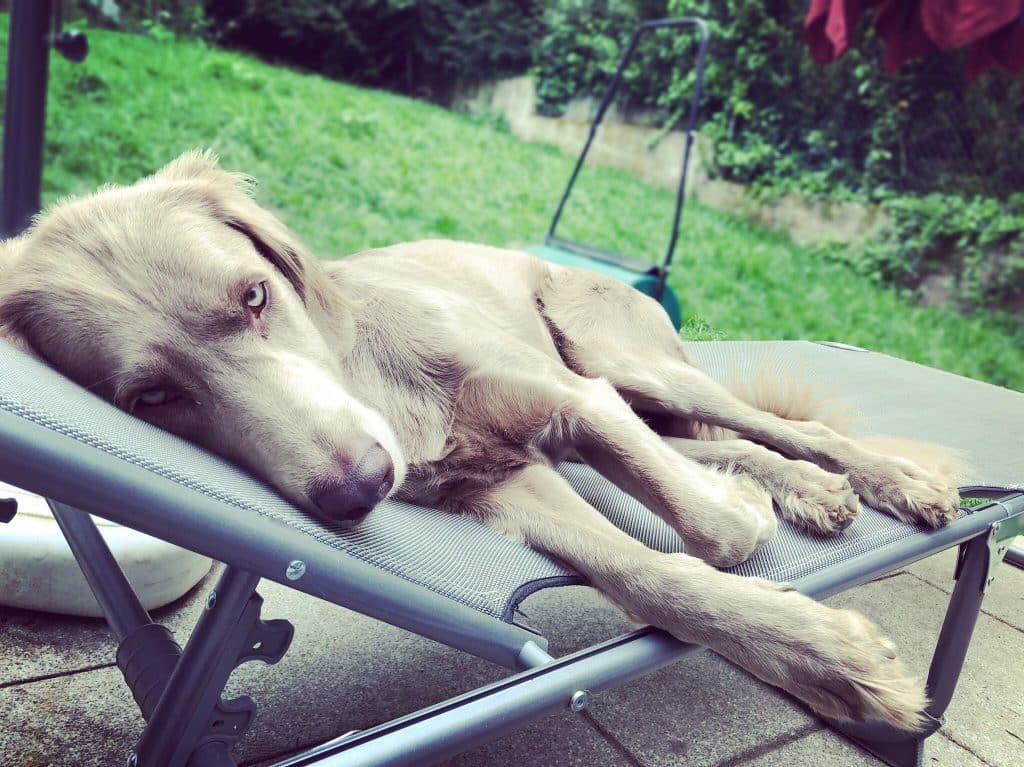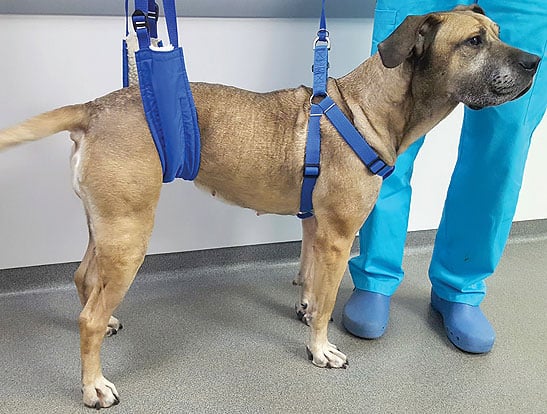Your four-legged friend has had surgery on his knee joint - now follows follow-up care for a torn cruciate ligament for the dog, which plays a key success factor.
In order to optimize the healing process, you should pay attention to the following points during aftercare for a torn cruciate ligament in dogs:
✓ Cool the knee joint for the first three to four days (including the day of the operation). Never cool for more than 20 minutes at a time. There is then a break of at least 20 minutes (local risk of hypothermia). If you use a frozen gel pack, be sure to wrap it in a cloth. From the 4th day onwards, no more refrigeration is allowed.
✓ In the first 2 weeks, your walks should not last longer than five to ten minutes. The patient must be kept on a short leash. Instead, walk short distances more often (four to five times). If it is very cold outside, the joint can be warmed up before going for a walk.
✓ Your dog can move freely around the apartment, but cannot climb stairs. He must be kept on a leash in the garden.
✓ In order not to restrict the movement of the knee joint, the wounds are usually only covered with a skin-friendly bandage. In order to avoid later infections, the wounds must be protected from intensive licking. A funnel is helpful for this.
✓ It is recommended to check the wound on the 3rd or 4th day after surgery. Removal of the (absorbable) suture material is routinely carried out after approximately ten to twelve days.
✓ Occasionally, fluid (so-called seroma) can accumulate in the wound area. In general it is a harmless phenomenon, but the leg should be protected more.
✓ Please administer the prescribed medication carefully. It is important to continue administering anti-inflammatory medication until recovery (ie, for several months). If you have any intolerances, please contact your veterinarian or us.
✓ Please take the patient for an orthopedic check-up in approx. 2 weeks.
Professional physiotherapy therapy and follow-up care for a torn cruciate ligament can then be started by a dog physiotherapist you trust and who is available.

Important information for aftercare for a torn cruciate ligament in dogs:
- If necessary, a special diet food (recommended for overweight dogs).
- Depending on the healing process and the surgical method , the patient must be kept on a leash for approximately 12 weeks. The length of the walks depends on the functionality and operation method of the operated knee. This time is usually needed so that the drill channels and screws in the bone can fuse properly.
- Overloading in the early postoperative period can have a negative impact on the overall result.
- We work in a “meniscus-friendly” way, meaning we do not destroy any intact menisci. A small percentage of patients may experience secondary meniscus damage several months after surgery. They make it necessary to mirror the joint.
- No known technique can restore the full function of the natural cruciate ligament.
For this reason, a cruciate ligament tear always leads to chronic osteoarthritis. In order to delay this, the following measures are recommended in the long term: ✓ Reduce weight
✓ Optimize exercise (e.g. strength training, no playing with sticks or ball games or similar)
✓ Anti-inflammatory measures (diet food, medication) also serve as aftercare for a torn cruciate ligament in dogs.
Physiotherapy during follow-up care for a torn cruciate ligament in a dog

According to Iris Challande-Kathmann, Semsales, CH:
Early and intensive physiotherapy is recommended for humans and animals and should be started after the stitches have been removed at the latest. It is better to introduce the patient to the physiotherapist beforehand.
The goals of physiotherapy aftercare for a torn cruciate ligament in dogs are:
- Reduce pain,
- Maintain/restore mobility (joints, muscles, ligaments, etc.).
- Promote/build coordination, strength and stamina
- Restore limb function
An individual rehabilitation program for each animal, adapted to the course of the disease, the therapy method and the needs/possibilities of the owner.
Physiotherapy can be started until the planned operation (advantages: pain relief,
exercises the dog is already familiar with, faster regeneration post-operatively).
Thermotherapy:
- Cold therapy: 1st day postoperatively. To do this, the knee joint is covered with a towel and a cold gel pad is placed on it for 3-5 minutes.
- Heat therapy: After approx. 1 week (joint not warm) can be used as preparation for passive movement therapy if necessary.
Massage:
- From day 1, massage the hind limbs and lumbar muscles 1-3 times a day, carefully mobilize the patella.
- Full body massage approximately once a week to combat tension caused by incorrect strain.
Passive movement therapy:
- From day 2, carefully move the knee joint passively 1-3 times a day at least 5 to 10 times, also taking other joints of the limb into account, especially the hip. Also mobilize the front and opposite sides as necessary.
- Stretching: From day 6, iliopsoas, thigh and lower leg muscles should be gently stretched daily.
Active movement therapy:
- Adjust the duration and intensity individually to the patient's reaction and progress:
Gait training: From day 1, very slow and short walks on a leash at least 3-5
times per day, no more than 5 minutes at the beginning - From week 1, integrate e.g. wavy lines and large circles (adjust the diameter, should not provide increased
relief) and walk uphill.
From week 1, progressive integration of coordination training: balance exercises such as standing on a trampoline,
Strength and conditioning training as aftercare for a torn cruciate ligament in dogs:
- Introduce sitting and standing exercises (should not hurt) and cavaletti work after approx. 5-6 weeks
- After 2 months of trotting stretches controlled on the leash - install, promote strength e.g. later with traction.
- Hydrotherapy:
- Underwater treadmill: Possible to start 48 hours after removing the stitches, build up slowly 1 to 3 times a week, adapt the duration, frequency and intensity to the animal's reaction. Up to 4 weeks post-op Duration maximum 15 minutes and very slow running in waist-high water (28-32°). The animal can be moved under control with 60% less strain and slightly increased flexion and is a good change for the animal that needs to be kept calm.
- Swimming: not before (10-) 12 weeks post-op due to increased stress caused by uncontrolled movement and strong jerky flexion of the knee, later very suitable for building fitness and muscle.
- Physical therapy:
possible from day 1, promoting healing and analgesia
- magnetic field therapy
- laser therapy
- electrotherapy: TENS - Program for at home:
passive exercise, massage and stretching 1-3 times a day by the owner after precise instructions, active movement therapy 3-5 times a day, integrated into walks. - Important:
Follow the surgeon’s timing recommendations. Dogs should not experience increased pain during exercises. Good analgesia is important. Regular check-ups with a physiotherapist; 1 to 3 times per week.
